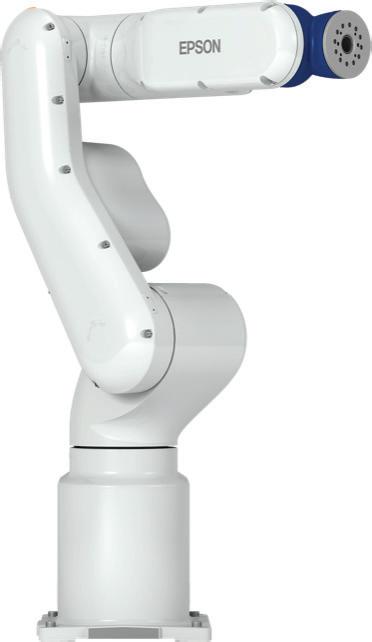
13 minute read
Collaborative Robotics Expand in Scope
20 20 COLLABORATIVE ROBOTS AW NOVEMBER 2020 NOVEMBER 2020 Collaborative Robotics
Expand In Scope






By David Miller, Automation World Contributing Writer

We all want to know what makes our co-workers tick and, perhaps, collaborative robots (cobots) are no different. Yet, for all the buzz about the growing prevalence of cobots in industry, there’s often a great deal of confusion over precisely how the term cobot is defined.
Therefore, as companies look to increase productivity, circumvent labor shortages, and reduce human contact in their plants with the help of cobots, it’s time to ask, “What does it truly mean for a robot to be collaborative?”
It’s important to note that there is no single, formal definition of what a cobot is. Rather, ISO standards 10218-1 and 10218-2 set forth four potential characteristics of collaborative robotic systems. These collaborative capabilities—safety monitored stop, speed-and-separation monitoring, powerand-force limiting, and hand-guiding—can all be achieved through the use of sensors, control systems, and peripheral devices, some



of which may already be integrated within a robot upon purchase, where others can be retrofitted to a pre-existing industrial robot. "There is no hard line between collaborative and non-collaborative robots,” says Andie Zhang, global collaborative robots product manager at ABB. “Cobots are basically a subset of industrial robots with different features, and almost all industrial robots we provide have the possibility of becoming more collaborative. From the user's perspective, they should think about what the specific operational problem they want to solve is and what the best way to do so is. Picking an option always depends on your application." Various approaches Highlighting the variety of available cobots, ABB, for example, offers a multitude of different products. While the company’s YuMi robot, which is trumpeted as being “inherently safe,” may spring to mind due






to its small size, power, and force limiting capabilities, ABB also offers SafeMove, a software system that integrates with ABB’s IRC5 robot controller family to allow its pre-existing industrial robot lines to engage in both safety monitored stops and speed and separation monitoring. Simply put, by utilizing pressure-sensitive safety mats, light curtains, or laser area scanners as inputs, SafeMove enables industrial robots to either slow down or stop entirely when workers enter the cobot’s hazard envelope.
The key distinction here is whether or not an application requires a human to work so closely to the robot that there is potential for a collision. If so, such as in a situation where task changeover is frequent or workers are required to continue processing parts after a robot has finished handling them, cobots like YuMi (which allows for hand-guiding and power-and-force limiting) may be the best option. However, because the laws of phys-
ics require these robots to be smaller and move slower to remain collision-safe at all times, speed and payload capacity may need to be sacrificed, thereby lowering throughput potential.
In contrast, if a robot is capable of working mostly on its own with humans occasionally entering its workcell, safety monitored stop and speed-and-separation monitoring technologies, which can be externally appended, may be preferable and come with the added benefit of being compatible with larger, faster industrial robots.
One technology company focused exclusively on transforming industrial collaborative robots into cobots is Veo Robotics. This company’s FreeMove system uses multiple camera sensors and an algorithmic computing platform to transform industrial robots into cobots. To read more about how Veo Robotics’ uses the ISO speed-and-separation monitoring standard to achieve its aims, read Automation World’s coverage of the technology at http://awgo.to/1093.

Other options and considerations The term cobot is even more loaded than the nuances of ISO standards 10218-1 and 10218-2 would initially seem to suggest. Even beyond the specific technologies that enable robotic systems to become more collaborative, the concept of a cobot brings with it certain end-user perceptions and expectations apart from the product’s electronic and mechanical capabilities.
As Joe Campbell, senior manager of applications development at Universal Robots, points out, the cobot designation is as much about stripping away complexity and providing flexibility via easy integration, programming, and operation as it is about safety features. To meet these needs, Universal Robots’ business model is oriented toward ease of use. In fact, Universal Robots’ market niche has long been small- and medium-sized enterprises, contract manufacturers, and other companies who—due to risk aversion, skills gaps, or lack of capital—cannot adopt more fully automated systems.
“We’re selling double digit numbers of robots into companies that I previously never would have made a sales call on in my entire career because they never would have qualified before,” Campbell says. “For instance, I know a 22-man machine shop that now has ten robots. Before, I wouldn’t have ever marketed to them because they wouldn’t have purchased traditional automation. Now they’re a huge part of this explosion in interest.”
That’s why a company like Epson Robotics, which has yet to release its own cobot line, feels that it has learned from trends
Epson Robotics o ers small SCARA and six-axis robots that can be programmed to work in a collaborative fashion

in the collaborative safety space and has something to offer customers who are eyeing a cobot purchase. According to Scott Marsic, senior product manager at Epson Robotics, when new entrants look to purchase their first robot, it is often their need for an intuitive user experience, scalability, and a low-cost product that incentivizes them to choose a cobot, over and above the need to actually share a workspace with their machine. In response, Epson Robotics has released its all-in-one line of small SCARA and six-axis robots, which Marsic feels can fulfill the same fundamental needs that many cobots do, even without the collaborative safety features. "The biggest feedback we've seen from people is that they purchase cobots because they see they're easy to use, easy to implement, and easy to place, but what they don't realize until after they've placed the cobot is that their throughput isn't going to be what they expected. They like the simplicity of the programming and the GUI (graphical user interface) that allows them to get up and running quickly, but they're not able to perform at the levels they really want to," Marsic says. "What we've seen from our builders, our customers, and our distributors is that, in some cases, cobots are not being used the way they were designed to be used. What people really need is simply ease of use."
The trade-offs Marsic indicates are the result of the need for power-and-force limiting cobots to remain below a certain threshold of size and speed, ensuring they are collision safe at all times. He argues that the reductions in throughput that result from these slower speeds may ultimately hurt one’s bottom line, offsetting the initial labor savings the cobot allows for. Still, even though these restraints may affect smaller, power-and-force limiting cobots, advances in speed-and-separation monitoring are helping larger, faster industrial robots circumvent these boundaries.
For example, Fanuc’s CR series cobots, which use speed-and-separation monitoring, can reach speeds of up to 1500mm per second and offer payload capacities of up to 35kg, which is the highest on the market, according to Fanuc. Greg Buell, senior engineer at Fanuc, anticipates the trend continuing toward cobots with longer reaches, higher speeds, and greater payload capacities as speed-and-separation monitoring technologies continue to improve.

A CR-35iA collaborative robot from Fanuc working in tandem with a technician on an automotive headliner gluing application.
The dual-arm YuMi collaborative robot from ABB is touted as the world’s fi rst truly collaborative robot.
Making a decision According to Campbell, cobots have historically been smaller and more simplistic than general industrial robots, largely because the companies producing them early on were highly specialized and sought to sell them to small- and medium-sized enterprises with a need for highly intuitive features. However, now that their popularity and functionality has expanded and major robotics manufacturers—such as ABB and Fanuc—have begun trying their hand at designing and selling collaborative robotic systems, end-users can expect larger, faster, and more powerful cobots to continue to proliferate. As a result, potential purchasers should anticipate a more diverse landscape of choices, though this may turn out to be a double-edged sword.
On the one hand, as options multiply, it is likely that products that are more closely tailored to manufacturer’s individual needs will become more common. On the other hand, more careful consideration may need to go into parsing the alternatives to select the one that is best suited to a company’s particular application. This latter process will

require keeping the trade-offs enumerated above firmly in mind.
Beyond that, it’s important to note that, even when investing in inherently safe, power-and-force limiting cobots such as ABB’s YuMi, some safety qualms may remain. For instance, regardless of how collision safe a cobot itself is, if it’s tooling or the objects it is handling possess sharp points or jagged edges, humans working in proximity to it can still be injured. Similarly, while a cobot engaged in a machine tending operation may be able to stop if it collides with a human worker, that does not mean that the door of a CNC or other device could not still slam on an operator’s arm. Even in applications where fencing has safely come down, a box or other manipulated item dropped due to a momentary loss of air pressure to a pneumatically actuated arm could find itself sliding across the floor. As such, situational awareness on the part of plant floor workers remains important and performing a risk assessment before deploying any particular type of cobot is absolutely indispensable.
Finally, those interested in cobots should keep a close watch, not just on individual robots, but the various peripheral and add-on technologies being developed and released to supplement pre-existing industrial robotic systems. As in much of industry, software for zoning and safety controls continues to take precedence in areas where physical barriers and other hardware would have once been required. In addition, products such as Touché Solutions’ T-Skin, a tactile safety sensor system which can be applied to the surface of industrial robots to allow them to come to a safe stop upon collision with human workers, as well as several advanced vision systems for speed-and-separation monitoring continue to be game-changers in the collaborative space, making faster, higher payload collaborative robotic systems ever-more feasible.
And for those who feel overwhelmed by the rapidly expanding suite of options presented by this seeming robotic takeover, it’s important to remember that whatever Hollywood films may have taught us, these cobots come in peace.
Segmenting your factory floor network improves operations
When talking about an industrial enterprise, the term IIoT (Industrial Internet of Things) is always mentioned and is often overused. However, nearly everyone can agree that there always is a benefit to getting the “right” data in a “sustainable” fashion from “edge” devices to individuals who can use the data to make better business decisions. A risk is that too much data collection, without proper foresight, can create a situation where a plant Ethernet network can be rapidly overwhelmed due to poor design.
It pays to collect data from the factory floor
• Real-time downtime analysis from one location (“A Single Pane of Glass”) can show instantly where resources need to be applied to increase productivity. Long-term analysis of this data can point to maintenance trends, staffing shortfalls, or process bottlenecks. • Older assets can be connected to the network and improve process uptime. Even older machines with just relay logic controls can be monitored with the right equipment. • Gathering data isn’t just about the traditional cycle time reporting issues. Predictive maintenance information such as monitoring the vibration on motors has been proven to reduce costly downtime.
Managing Network Traffic is more important now than ever
Over the years, the number of devices on the factory floor has exploded. Often, networks were augmented as an afterthought without regard to problems that would occur down the road. Currently, many large networks have bottlenecks due to speed issues and the continued existence of unmanaged switches. Multicast protocols often initially meant for a small cell can inundate and overwhelm a network without the proper managed switches in place.
The Convergence of IT and OT
The IT world (Information Technology) and the OT world (Operational Technology) are coming together rapidly. Both sides have the same goals, but often go about the process in different fashions. Both sides always agree that a good balanced and segmented network is critical. Sometimes this is achieved via a “top down” design by having versions of the office switches down to the factory floor, where special
Figure 1 – Problems will occur if multiple machines with the same IP address allocation pattern were simultaneously plugged in to a plant network.

consideration must be made for environmental factors such as heat and vibration.
Industrial Routers can provide effective segmentation and connectivity
How does an organization handle networking equipment which can come from the outside? It is quite common now for machinery to come in from an outside vendor or OEM. Is it asking “too much” to be able to keep the original IP address scheme? An industrial router or switch with NAT (Network Address Translation) capability may be a solution.
The multiple machine cell case
Consider that an OEM over the years has delivered 20 machines consisting of a PLC, HMI, and a VFD (Variable Frequency Drive). Because they were manufactured originally as individual machines, the OEM used the same IP address allocation pattern. 192.168.1.1 for the PLC, 192.168.1.2 for the HMI, etc. (Figure 1)
What happens when all 20 machines need to be connected?
In the example above, if all machines were simultaneously plugged in to the plant network, IP address conflicts would happen. Some of the problems are documentation headaches, sudden introduction of multicast protocols into the greater network, and extra unexpected reprogramming of individual assets.
A device which has NAT capabilities (Network Address Translation) will help
Employing a switch or router with NAT capabilities means that a factory floor automation engineer can design a table which gives a one-to-one correspondence from an internal address to an “external” plantwide address. That way nothing needs to change on the edge while maintaining security and uniqueness at the plant network level.
Add security with firewall rules
Often another advantage with these types of devices is the fact that one can add firewall capability for even more security. For example, if there is a SCADA machine on the plant network that needs to just talk to the PLC only, rules can be made to restrict all other communications except for requests from the SCADA computer.
Routers and switches with NAT (and Port Forwarding) capability are only one way that networks can be segmented and made more secure. Many organizations have implemented VLANs (Virtual LANs) to segregate traffic. Make sure that you consult professionals on both the IT side and the OT side about working solutions to help improve the operation of your network and enhance security as your enterprise grows.
By John Kan,
Motion Industries John Kan is Connectivity Product Manager with the Mi Automation Solutions Group/ Braas Division at Motion Industries.


